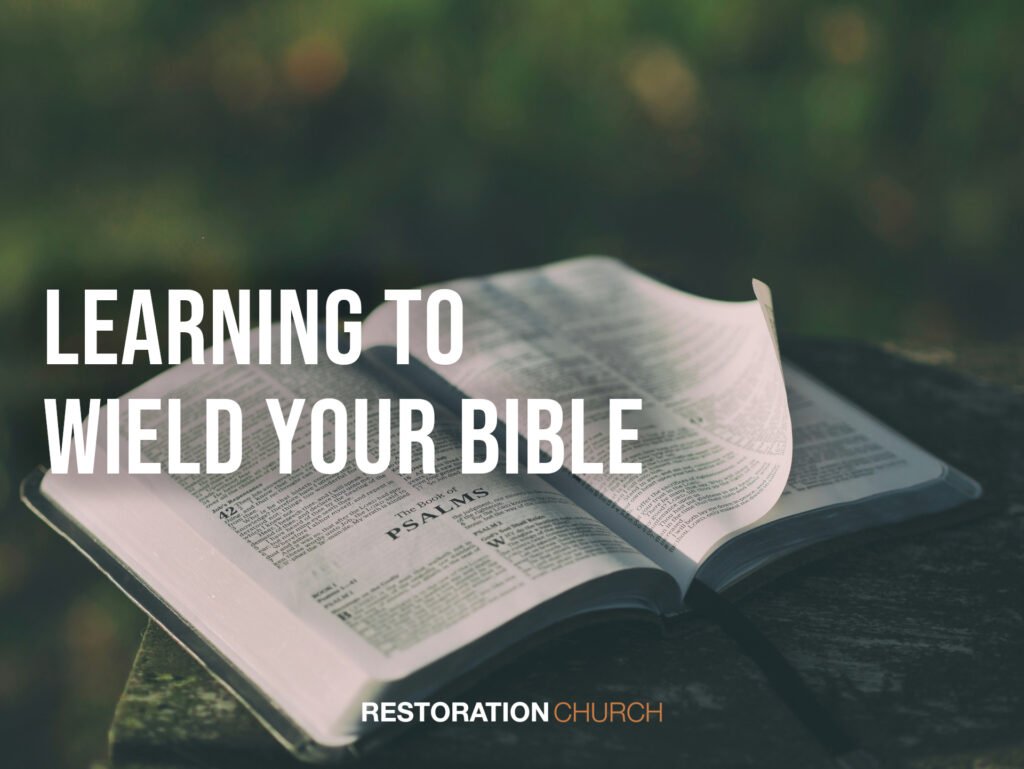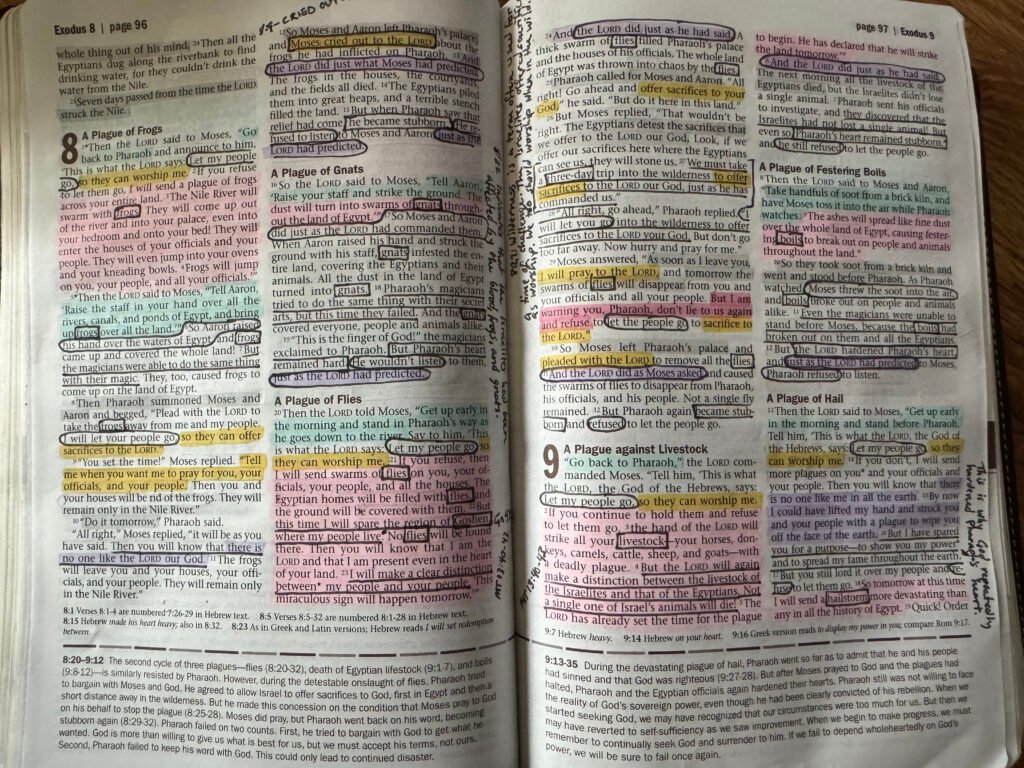Learning to Wield and study the Bible

Excalibur. The Master Sword. The Sword of Gryffindor. Andúril. These are just a few of the famous swords which have captivated us as a culture. From fantasy movies and video games to fairy tales, we hear about powerful swords. Despite this, we rarely hear about the most powerful and most important one of all: the Sword of the Spirit. While it requires one to study the bible, it can be the strongest sword of them all.
In Ephesians 6, Paul talks about donning the armor of God. After listing the armor we should adorn, he lists a weapon: the Sword of the Spirit, which is the Word.
‘Therefore take up the whole armor of God, that you may be able to withstand in the evil day, and having done all, to stand firm. Stand therefore, having fastened on the belt of truth, and having put on the breastplate of righteousness, and, as shoes for your feet, having put on the readiness given by the gospel of peace. In all circumstances take up the shield of faith, with which you can extinguish all the flaming darts of the evil one; and take the helmet of salvation, and the sword of the Spirit, which is the word of God, ‘
Ephesians 6:13-17
I play tabletop roleplaying games, video games, and enjoy fantasy adventure movies. For me, the idea of wielding the bible like a sword is much “cooler” than saying “I study the bible”.

Wield and study the Bible
So how does one go about “wielding” a bible like a sword? Good question! In another post, I talked about the importance of the word to fend of attacks of the enemy. I would like to expand on that a bit further.
How does sword fighting even work?
When a sword fighter begins training, they begin by selecting a form (or style) to start with. They train with that style until they have developed a mastery of it. I guess they’re probably done then, right? Nope! Each sword form has distinct advantages and disadvantages because of how it’s used.
This means a fighter should be familiar with many different forms in order to both defend and attack against an opponent. In Ephesians 6:17, Paul refers to scripture as our sword. Our opponent (Satan) will attempt to attack our different weak spots, so we must be ready.
Memorizing verses for a given topic (especially a weak area for you) is similar to practicing sword forms. It allows you to recognize the opponent’s tactics and adjust your defense (and offense) accordingly to rebuke the attacks of the enemy. Cool, right?

study the bible to become proficient
Like anything else, becoming proficient with your sword requires time, effort, and practice. Many times, people complain about the work involved here. I hear several complaints such as “I don’t have time”, “it’s too hard”, “it’s boring”, or “I can’t focus”. I have even made such excuses myself.
The truth is: that’s what our enemy wants. He wants us defenseless. He wants us to give up. Can you imagine how much differently the Lord of the Rings would have ended if Aragorn complained his sword was too heavy and refused to pick it up? What about if Luke Skywalker complained that training with Yoda was too hard? They probably wouldn’t be stories worth telling.
I would like to take a minute to address some of these complaints.
it takes too much time to study the bible
In some cases, depending on your goals, this could be true. I’m currently reading through the bible in a year, which requires me to read 3-5 chapters a day. This can take up to an hour and a half depending on distractions. I recognize that not everyone has that kind of time to devote to scripture.
The good news is: you can do what you can! Anything is better than nothing. When I started seriously reading the bible a few years ago, I was trying to read a whole book of the bible every day or two. It took a lot of time and I found that I wasn’t retaining anything I had read. Then I went the opposite direction and started reading it one small passage at a time (from one header to the next). This was usually about 4-5 verses.
The bottom line here is that you should do what you can handle. If that’s 3-4 verses a day, then do that. If it’s 3-4 chapters per day, do that. You should try to find a pace that doesn’t burn you out, but also that you can be consistent with. Quality of your reading is more important than quantity of your reading.
it’s too hard or boring to study the bible
This can be true. Fortunately, we live in an amazing time where many different versions of the bible are available to us. Knowing which version is best for you can make a big difference in how you learn and understand what scripture says. I know when I chose mine and got into it, I felt like Harry Potter in that one scene.

Which translation should you get?
To help you find the correct bible and translation for you, I would like to give a brief overview of the different versions. I think a good starting place if you’re struggling to read the bible is to look at the reading level of the translation. The table below helps to illustrate this further so you can see the differences. The goal here is to find a bible that is good for you, not to impress others, so don’t worry about the reading level as a reflection of you.
| Translation | Reading Level |
|---|---|
| King James Version (KJV) | 12 |
| New American Standard Bible (NASB) | 11 |
| English Standard Version (ESV) | 10 |
| New International Version (NIV) | 7-8 |
| Christian Standard Bible (CSB) | 7 |
| New Living Translation (NLT) | 6 |
Personally, I use a NLT bible for my “daily driver” because it’s relatively easy for me to read, which allows me to focus on the content rather than trying to understand the grammar. That being said, I do also have several other bible translations so I can compare based on my needs. If you’re not sure which one of these is a good match for you, I recommend comparing the translations.
Please note: I do not recommend getting “The Message (MSG)” version of the bible, as it’s closer to someone giving you a summary than actual scripture even though it is easier to read.
How accurate are the translations?
An important question to ask when digging into scripture to learn the meaning and listen for God is, “how accurate is this translation versus the original text?”. An additional, though maybe less obvious question is, “how was it translated?”. Part of the reason these different translations vary in terms of reading level has to do with the translation method used.
I would like to go over the two primary methods that bible translations are created so you can decide which is right for you. The two methods are called word-for-word and thought-for-thought. Word-for-word translators literally go word by word from the original texts and translate each one individually. This can make for choppier sentences and more difficult reading. Thought-for-thought means the translators read a sentence or a verse, determined the meaning of the thought, and tried to match it as closely to the original while still being easy to understand.
The table below shows which translations I mentioned before fall into each one of these categories.
| Translation | Type |
|---|---|
| King James Version (KJV) | WFW |
| New American Standard Bible (NASB) | WFW |
| English Standard Version (ESV) | WFW |
| New International Version (NIV) | TFT |
| Christian Standard Bible (CSB) | TFT |
| New Living Translation (NLT) | TFT |
Using the two tables here, you can decide which reading level and which translation type is right for your goals and abilities. I have also found value in using sites like bible.com and biblehub.com to compare the text in different translations if I’m struggling to understand something.
I get Distracted when I study the bible
Seeing as how I have ADD, I can identify with this one very well. I often have trouble sitting down to read a book about anything. What I have learned works for me is writing in my books. Although it may seem like sacrilege to some people, what’s the point in having a book if I can’t even read it?
I have read and tried many different highlighting systems for my bible study and have even done some different things while reading books about other things. I would like to focus on how these highlighting techniques help me stay focused and then I will talk about the highlighting method I use.
How highlighting helps me when i study the bible
I have found that highlighting, circling, and drawing in my bible help me in multiple ways. Although I’m sure it looks like chaos to someone else, it makes it easy for me to understand what I’m reading and focus on things that are important to me.
Makes it easy to find things
Because I have an established patter for colors and shapes, it is really easy for me to find what I’m looking for if I need to go back and look something up. This is because each color has a specific meaning, so I can just skim for that color rather than re-reading the whole chapter or book.
I also underline things that stand out to me, which makes it easy to find verses that I can relate to or that I thought were profound if I need to search for advice or something useful.
Breaks apart walls of text
As I mentioned before, I highlight things with different colors. This helps me to parse (fancy word for organize and understand) what I’m reading better because I’m categorizing things in a visual way. I can look at a paragraph, see the colors, and immediately understand an overview of what’s going on in the paragraph. This makes it easier for me to digest as I’m reading and when I revisit the scripture.
Allows me to pay more attention
When I begin reading, my brain has set categories it’s going to look for (based on highlighting colors). Because I’m trying to identify whether verses can fit into these categories, I’m engaged with the scripture. For me to accurately highlight with the right color, I have to read a verse, understand what it’s saying, and then decide which (if any) category it falls into.
It may take a bit longer when you first start to study the bible, so don’t be too hard on yourself. After doing it several times, it will become second nature and you’ll be able to recognize the categories much faster and easier.

How I study the Bible
Finally, lets get into the fun stuff: highlighting your bible. I have found a set of categories that make sense to me, so I use these styles while reading (or wielding) my bible. Feel free to try them out and modify whatever you want. Let’s go through each category and identify what it is!
God’s Character and attributes
While reading through scripture, I’m always looking for what it says about God. This may be telling me WHO God is (Yahweh, Elohim, etc), it could be telling WHAT God did (God was with Joseph), or HOW God interacts (God spoke to Moses). I use purple because I associate purple with royalty.
God’s Promises and prophecy
Whenever I see something in scripture that God is promising such as a covenant with Moses, a covenant with Abraham, or Jesus’ promise to send an advocate. I also use this color to highlight prophecy which points to future events. I use pink because God’s promises show his love for us.
Worship, Praise, and Prayer
Only recently, I started highlighting spots where people worship, praise, or pray to God. As a worship leader, I think it’s important to recognize who, when, how, and why people worship. I use yellow to signify this because it’s easy to spot and it shouts “glory” in my mind.
Directives, commandments, and Examples
It is often very easy to spot directives or commands. This is when God tells us we should be doing something or tells us not to do something. I also use this color in some cases to highlight examples I want to follow. I use green because green means go.
Warnings, sin, and punishment
For me, it is also important to point out sin and warnings God gives us about doing certain things. I have also started using this to show when God punishes people. Red is my color for warnings, sin, and punishment because it often means stop.
My Identity according to God
I find that one of the hardest things to remember and focus on is my identity according to God. All too often, I get insecure and worried about what people will think of me and who I am. I need to remember that God tells me who I am. I use blue to indicate verses which address my identity.
Context (People, places, culture, etc)
For me, keeping track of people and places has been difficult (especially with all of these weird names). It’s hard to keep track of where people have gone and who they’re with. I use grey to indicate things like this because it’s there, but it’s easy to ignore if I’m not looking for it.
Important words or phrases
As I read through scripture, I find that certain words or phrases seem to jump off the page at me. This could be words I need to define, words I want to provide a pronunciation for, or words that need special focus. For this, I draw a rectangle around the word or phrase.
REpeated Words or phrases
I’ve always heard that if you see something being repeated when you study the bible, you need to pay attention to that. Circling the repeated words or phrases helps me to visualize how often a given word or phrase is being used so I can spot it easily.
Verses that stand out
Finally, I often come across verses which strike me as profound, thought provoking, or undeniable truth. I like to draw attention to these verses by underlining them.
Starting your own journey to study the bible
I know that when I first started looking into highlighting my bible, I was somewhat intimidated and wanted to see actual examples of what their highlighted bibles look like, so I have put a few pictures of my bible below for you to look at. At the end of the day, this system is for YOU, so there’s no right and wrong. There’s only what works and what doesn’t work, so make it your own!
I also struggled with uncertainty about whether I was highlighting the “right” things. Again, this system is for YOU, so you should highlight according to what you think and feel when you read. One person might highlight something as a directive while another would see it as a promise. That’s okay!




Now that you know how I study the bible and the benefits it provides me, I encourage you to find your sword (if you haven’t already) and start learning some sword forms. Please let me know if you have questions or would like more clarification on how I study my bible at tim@restorationqc.church.
More Posts

Learning to Wield and study the Bible
Paul likens scripture to a "Sword of the Spirit", emphasizing preparedness against evil. I'll show you how to study the bible for knowledge and memorization.

Preparing for Famine
Life's feasts and famines aren't always literal; they include hardships like financial woes or depression, and preparation for such times is essential.

Meet Our Pastor: Jeff Schulz
Jeff Schulz, passionate Associate Pastor of Outreach/Evangelism at Restoration, focuses on helping needy and equipping others for outreach.

